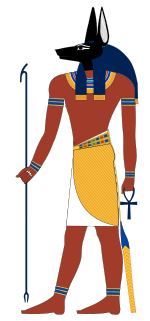
Back Anoebis Afrikaans Anubis ALS Anubis AN أنوبيس Arabic انوبيس ARZ অনুবিছ Assamese Anubis AST Anubis Azerbaijani Анубіс Byelorussian Анубис Bulgarian
| Anubis | ||||||
|---|---|---|---|---|---|---|
 | ||||||
| Name in hieroglyphs |
| |||||
| Major cult center | Lycopolis, Cynopolis | |||||
| Symbol | Mummy gauze, fetish, jackal, flail | |||||
| Personal information | ||||||
| Parents | Set and Nepthys, Osiris (Middle and New kingdom), or Ra (Old kingdom). | |||||
| Siblings | Wepwawet | |||||
| Consort | Anput, Nephthys[1] | |||||
| Offspring | Kebechet | |||||
| Equivalents | ||||||
| Greek equivalent | Hades or Hermes | |||||

Anubis (/əˈnjuːbɪs/;[2] Ancient Greek: Ἄνουβις), also known as Inpu, Inpw, Jnpw, or Anpu in Ancient Egyptian (Coptic: ⲁⲛⲟⲩⲡ, romanized: Anoup), is the god of funerary rites, protector of graves, and guide to the underworld, in ancient Egyptian religion, usually depicted as a canine or a man with a canine head.[3]
Like many ancient Egyptian deities, Anubis assumed different roles in various contexts. Depicted as a protector of graves as early as the First Dynasty (c. 3100 – c. 2890 BC), Anubis was also an embalmer. By the Middle Kingdom (c. 2055–1650 BC) he was replaced by Osiris in his role as lord of the underworld. One of his prominent roles was as a god who ushered souls into the afterlife. He attended the weighing scale during the "Weighing of the Heart", in which it was determined whether a soul would be allowed to enter the realm of the dead. Anubis is one of the most frequently depicted and mentioned gods in the Egyptian pantheon; however, no relevant myth involved him.[4]
Anubis was depicted in black, a color that symbolized regeneration, life, the soil of the Nile River, and the discoloration of the corpse after embalming. Anubis is associated with his brother Wepwawet, another Egyptian god portrayed with a dog's head or in canine form, but with grey or white fur. Historians assume that the two figures were eventually combined.[5] Anubis' female counterpart is Anput. His daughter is the serpent goddess Kebechet.
- ^ Lévai, Jessica (2007). Aspects of the Goddess Nephthys, Especially During the Graeco-Roman Period in Egypt. UMI. Archived from the original on 3 April 2023. Retrieved 15 November 2021.
- ^ Merriam-Webster's Collegiate Dictionary, Eleventh Edition. Merriam-Webster, 2007. p. 56
- ^ Turner, Alice K. (1993). The History of Hell (1st ed.). United States: Harcourt Brace. p. 13. ISBN 978-0-15-140934-1.
- ^ Johnston 2004, p. 579.
- ^ Gryglewski 2002, p. 145.
© MMXXIII Rich X Search. We shall prevail. All rights reserved. Rich X Search